A Visual Guide to Peppers
 Eating spicy food is a lot like running a marathon. They both hurt while you’re doing them, and the next day can be pretty painful, too. You have to fight the urge to quit. Crying is par for the course. Yet you persevere, all the while knowing that you’re going to sign up for the same suffering again in the future.
Eating spicy food is a lot like running a marathon. They both hurt while you’re doing them, and the next day can be pretty painful, too. You have to fight the urge to quit. Crying is par for the course. Yet you persevere, all the while knowing that you’re going to sign up for the same suffering again in the future.
The world is cuckoo for chilis. Restaurants compete to have the spiciest wings, hottest chili, and most tear-inducing sushi. Competitors on television shows and YouTube series sear the inside of their mouths for our viewing pleasure. Self-proclaimed pepper-heads are always working to bring hotter and hotter peppers to market. In fact, the most tongue-blistering varieties we have now—ones with ominous names like the Carolina Reaper and Trinidad Scorpion—didn’t evolve naturally. They are the result of systematic crossbreeding designed to create chilis so packed with heat that only the bravest (or most foolhardy, depending on your point of view) would dare try them.
Eating spicy foods satisfies the deeply ingrained human need to test our limits and see how much discomfort we can take. That’s not the only reason we’re drawn to spicy foods, though. The pain they cause seems to stimulate the release of endorphins, part of the body’s endogenous opioid system, which accounts for why spicy foods “hurt so good” instead of just plain hurting.https://www.sciencedirect.com/science... Capsaicin, the chemical in hot peppers that imparts the characteristic burning sensation, is anti-inflammatory and has numerous health benefits.https://www.ncbi.nlm.nih.gov/pmc/arti... https://pubmed.ncbi.nlm.nih.gov/26093...
Can you feel the burn?
Chili, Pepper, Chili Pepper: What’s the Difference?Sometimes the English language is unnecessarily confusing. This is one of those times.
Chilis all belong to the genus Capsicum, while peppers are a separate plant belonging to the genus Piper. The black pepper and white pepper on your spice rack are Pipers. However, the cayenne pepper and red pepper flakes next to them are Capsicums, as are bell peppers and all the fruits (yes, fruits) we lump into the category of “chili peppers.” Also, chili, chile, and chilli are all acceptable spellings for members of the Capsicum genus depending on where you live.
Confused yet? Sorry about that, but don’t fret. The difference only matters if you’re a botanist or you’ve been cornered by an incredibly pedantic foodie at a party. For common usage, feel free to use the terms chili (chile), pepper, and chili pepper interchangeably.
What is the Scoville Scale?The Scoville Scale describes how hot a given pepper is using a unit of measure called Scoville Heat Units, or SHU.
In the original method for rating peppers, developed by the eponymous pharmacist and researcher Wilbur Scoville, a panel of tasters judge the heat level of different peppers. Today, food scientists employ high-performance liquid chromatography to measure how many capsaicinoid compounds a pepper contains, but human tasters still provide subjective ratings and validate the results.
Bell peppers rate a 0 on the scale. There is no upper limit. Currently, the hottest known pepper on the planet, the mysterious sounding Pepper X, claims to clock in at more than three million SHU. That would make it 600 times hotter than the average jalapeño!
Hot Pepper SafetyCapsaicin is an oily substance that can burn your skin and mucous membranes if you aren’t careful. The best way to avoid chili burns is:
Always wear gloves when cutting hot peppers.Never touch your eyes when cooking with chilis.Wash your hands with dish soap immediately after handling hot peppers.Be careful not to inhale dried and ground (powdered) chili peppers. Chefs who work with the chilis at the top of the Scoville scale will even wear respirators!If you forget the gloves and your hands feel like they are on fire, try washing them with rubbing alcohol, vodka, vinegar, baking soda, and/or dish soap. Each of these substances can neutralize and wash away the capsaicin.
The casein in dairy products can help, too. Drinking milk or eating yogurt will ease the pain in your mouth. You can also dunk your burning hands in milk if washing them hasn’t helped. However, should you be so unlucky as to touch your eyes with chili hands, the only solution is to flush them thoroughly with water.
Ultimately, though, the best course of action is prevention. Once you’ve burned yourself, these remedies are only going to provide moderate relief. You’ll still have to live with the pain for a while.
10 Types of Chili Peppers You Should KnowVariety is the spice of life. When it comes to culinary delight, one of the most fun—and potentially most painful ways—to mix it up in the kitchen is by experimenting with the spice level of your food. Here are some chilis you might want to try.
1. Jalapeño Peppers Also known as:
Also known as:Chipotle pepper (when smoked and dried), chile gordo (“fat chili”)
How hot are jalapeño peppers?2,500 – 8,000 SHU
Jalapeño facts:Native to MexicoUsed in a wide variety of Mexican and Tex-Mex dishesNot very spicy as chili peppers go, but enough to bring some heatSmooth-skinned fruit that grows 2 to 6 inches in lengthGenerally eaten while green, but you can let them continue to ripen on the plant until they are redTry these jalapeño recipes:Spicy Chorizo Stuffed JalapeñosBuffalo Ranch Chicken Stuffed Jalapeños with Bacon 2. Serrano Peppers
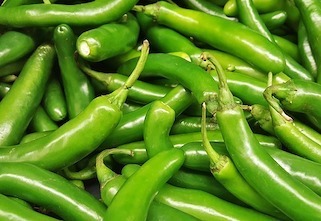
10,000 – 23,000 SHU
Serrano pepper facts:Native to MexicoCan substitute for jalapeño peppers in most dishes, and vice versa, though serranos are a bit hotterGrows 1 to 4 inches longUsually eaten raw, frequently in salsas, sauces, and relishesTry these serrano pepper recipes:Whole30 Baked Sticky Asian WingsSpicy Serrano Hot Sauce (fermented!)3. Habanero Peppers
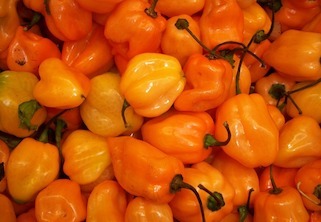
100,000 – 350,000 SHU, but can be even hotter
Habanero pepper facts:Originally from South America but now grown mostly in MexicoCommonly used in Mexican and Central American cookingRelated to much spicier peppers like the ghost pepper and Scotch BonnetShort, plump fruit usually 1 to 2 inches longCome in a variety of interesting colors and flavors, from traditional orange-colored habanero to the dark purple-brown chocolate habaneroJust one habanero pepper delivers more than the recommended daily allowance of vitamin CTry these habanero pepper recipes:Habanero ChiliPeach Habanero Salsa4. Poblano Peppers

Ancho chili (when dried)
How hot are poblano peppers?1,000 – 2,000 SHU
Poblano pepper facts:Native to MexicoThe largest pepper on this list, growing 3 to 6 inches long and about 2 to 3 inches wideAlso the mildest pepper on this listUsually eaten cooked, not rawTry these poblano pepper recipes:White Chicken ChiliKeto Tex-Mex Stuffed Chicken BreastsChili Relleno Casserole5. Mirasol Peppers
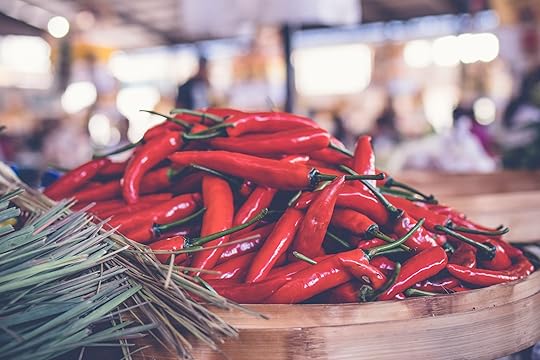
Guajillo chili (when dried), travieso chili
How hot are mirasol peppers?2,500 – 5,000 SHU
Mirasol pepper facts:Originally from MexicoAlso grown in Peru and popular in Peruvian cookingBright red, skinny pepper that grows 3 to 6 inches longOften used dried (as guajillo)Best known as a central ingredient in mole sauceTry these mirasol/guajillo pepper recipes:Carne AdobadaSmoky Guajillo SalsaClassic Ground Beef with Guajillo Chiles6. Cayenne Peppers

30,000 – 50,000 SHU
Cayenne pepper facts:Native to French GuyanaBright red, skinny, curve pepper that grows 2 to 5 inches longMost often used in dried and ground form to bring the heat to a wide variety of dishes and cuisinesThe “red pepper flakes” you buy at the grocery store or sprinkle on your pizza are most likely cayenne peppersTry these cayenne pepper recipes:Hot Chili Pepper TrufflesHomemade Cayenne Pepper Sauce7. Thai Chilis
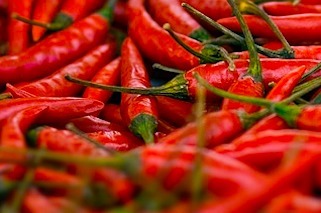
50,000 – 100,000 SHU
Thai chili facts:The term “Thai chili” may refer to many different species, most often bird’s eye chilisSkinny, deep red fruit measuring 1 to 2 inches longUsed both fresh and dried in chili pastes, sauces, stews, and curriesTry these Thai chili recipes:Whole Roasted Green Curry Chicken in Coconut MilkSesame Chicken and “Rice” with Fiery Ginger and Chile SauceTom Yum Soup8. Scotch Bonnets
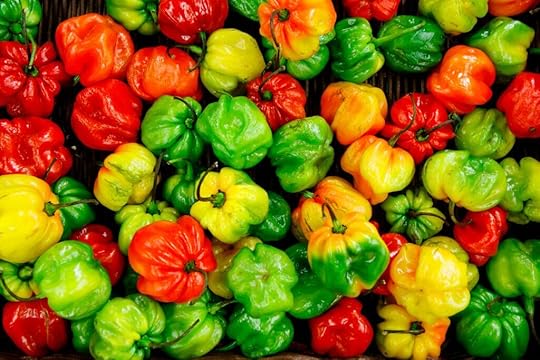
Caribbean red peppers, bonney peppers, goat peppers, githeyo mirus
How hot are Scotch bonnets?100,000 – 350,000 SHU
Scotch bonnet facts:Native to the CaribbeanAlso popular in the MaldivesShort, roundish pepper grows 1 to 2 inches longSo named for its resemblance to Scottish tam o’ shanter hatsTraditionally used to make Jamaican jerk seasoningTry these Scotch bonnet recipes:Poul Ak Nwa (Cashew Chicken)Jamaican Jerk Sauce9. Ghost Peppers

Bhut jolokia
How hot are Ghost bonnets?855,000 – more than 1 million SHU
Ghost pepper facts:Native to northeast IndiaRed, yellow, orange, or brown pepper 2 to 3 inches in lengthOnce considered the world’s hottest pepper, but has since been beaten by the Trinidad scorpion pepper and the Carolina ReaperFirst pepper to be measured over 1 million SHUUsed by the Indian military in “chili grenades”Try these ghost pepper recipes:Ghost Pepper WingsGhost Pepper SalsaChili Salt10. Carolina Reapers

1.4 million to 2.2 Million SHU
Carolina Reaper facts:Wrinkly, roundish red pepper measuring 2 to 3 inches long with a pointed tailCreated by Ed Currie of the Puckerbutt Pepper Company (yes, really)Currently holds the world record for hottest pepper (as of October, 2021)Can cause severe burns if eaten raw or handled with bare handsTry these Carolina Reaper recipes:Are you serious? Don’t try this at home!
Let us know in the comments: What’s the hottest thing you’ve ever eaten? Do you have a favorite chili that didn’t make the list? Maybe the hearty Anaheim, guindilla verde, or aji amarillo?
References https://www.sciencedirect.com/science/article/pii/S1389041720300772https://www.ncbi.nlm.nih.gov/pmc/articles/PMC6273101/https://pubmed.ncbi.nlm.nih.gov/26093270/ (function($) { $("#dfETth4").load("https://www.marksdailyapple.com/wp-ad..." ); })( jQuery ); 
The post A Visual Guide to Peppers appeared first on Mark's Daily Apple.



Mark Sisson's Blog
- Mark Sisson's profile
- 199 followers



